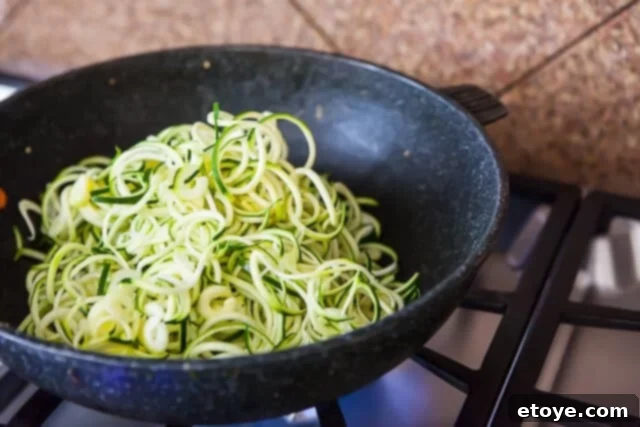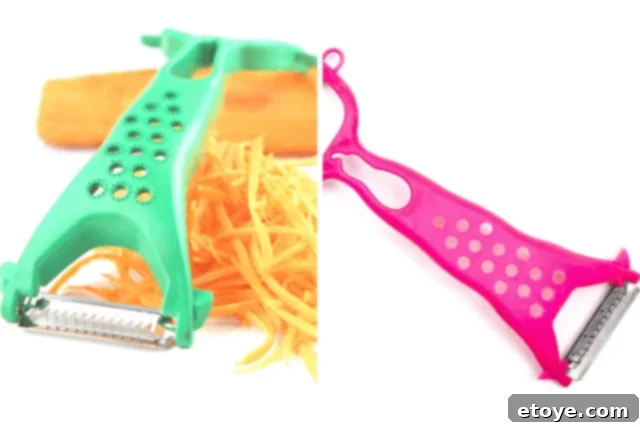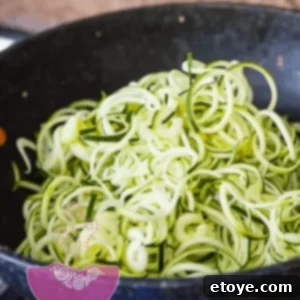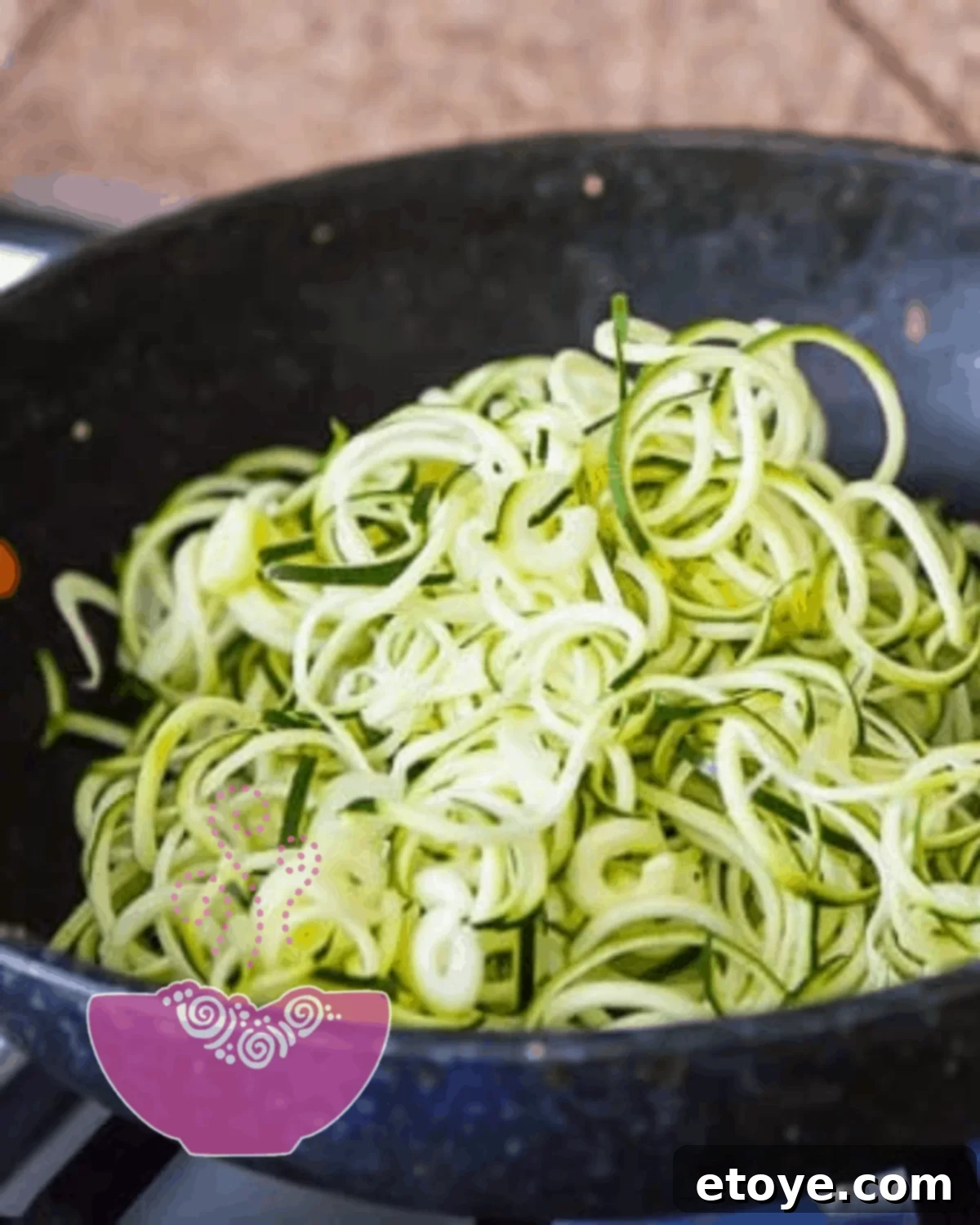Unlock the incredible versatility of zucchini and transform it into delicious, low-carb noodles for an array of healthy and satisfying meals. Whether you’re a seasoned chef or a kitchen novice, mastering the art of creating and cooking zucchini noodles, affectionately known as “zoodles,” is surprisingly simple. This comprehensive guide will walk you through everything you need to know, from selecting the perfect zucchini to choosing the right spiralizing tool and preparing your zoodles to perfection, ensuring they absorb every drop of your favorite sauces.

What Are Zucchini Noodles (Zoodles)?
Zucchini noodles are exactly what they sound like: thin, spaghetti-like strands made from fresh zucchini. This popular vegetable, also known as courgette in many parts of the world, has gained immense popularity in recent years as a fantastic, healthy alternative to traditional pasta. Zoodles offer a naturally gluten-free, low-carb, and low-calorie base for your favorite dishes, making them ideal for various dietary needs, including keto, paleo, and gluten-free lifestyles. Beyond their health benefits, zucchini noodles boast a delicate flavor and a tender-crisp texture that beautifully complements a wide range of sauces and ingredients.
The beauty of zoodles lies in their simplicity and adaptability. Unlike conventional pasta, which requires precise cooking times and can quickly become mushy if overcooked, zucchini noodles are incredibly forgiving and cook in a fraction of the time. They are a brilliant way to sneak more vegetables into your diet without sacrificing the comfort and satisfaction of a hearty pasta dish.
The Rise of Zoodles: A Healthier Pasta Alternative
The journey of zucchini noodles from a niche health food to a mainstream culinary trend is fascinating. Their popularity surged dramatically with the rise of the Paleo and Keto diets around 2016-2017, as people actively sought grain-free and low-carbohydrate alternatives to traditional pasta and rice. Zoodles quickly became a staple for those looking to reduce their carb intake or simply increase their vegetable consumption.
Beyond specific diet trends, zucchini’s versatility has also captured the attention of popular culture. For instance, Meghan Markle, the Duchess of Sussex, famously shared her recipe for a slow-cooked vegan “Bolognese” using zucchini, affectionately dubbed her “Sexy, Filthy Mush.” While the exact dish might vary, the anecdote highlights how zucchini, in all its forms, has become a go-to ingredient for healthy and inventive cooking.

Zoodles have quietly but firmly established themselves as a go-to ingredient for light, flavorful meals. They shine in various culinary applications, from replacing spaghetti in classic Italian dishes to forming the base of vibrant Buddha bowls, where they expertly catch all the delicious flavors of dressings, proteins, and fresh vegetables. Their quick cooking time and nutrient-rich profile make them an ideal choice for busy weeknights and health-conscious eaters alike.
Choosing the Perfect Zucchini for Spiralizing
The quality of your zucchini directly impacts the quality of your zoodles. Here are some tips for selecting the best zucchini:
- Firmness: Always choose zucchini that feels firm to the touch. Avoid any that are soft, mushy, or have wrinkled skin, as these are signs of spoilage or dehydration.
- Skin: Look for zucchini with smooth, shiny, and unblemished skin. Discoloration or deep cuts can indicate internal damage.
- Size: Medium-sized zucchinis (about 6-8 inches long and 1.5-2 inches in diameter) are generally ideal for spiralizing. Larger zucchinis can have a higher water content and larger seeds, which can make your zoodles watery and less palatable. Smaller ones might be harder to handle with some spiralizers.
- Organic vs. Conventional: While not strictly necessary, opting for organic zucchini can be beneficial to avoid pesticides, especially since you’ll be eating the skin.
There’s no need to peel your zucchini before spiralizing! The skin adds extra nutrients, fiber, and a beautiful vibrant green color to your noodles.
Spiralizing Zucchini Noodles: Your Guide to Tools and Techniques
The most crucial step in making zucchini noodles is achieving the right shape. We’re aiming for long, consistent strands that mimic traditional pasta, sturdy enough to hold up against robust sauces. Thankfully, creating these perfect strands is much simpler than making pasta from scratch. You can achieve this with a few different tools, catering to various budgets and frequency of use.
Level 1: The Everyday Vegetable Peeler (For Casual Zoodlers)
For those who enjoy zoodles occasionally or are just starting, a simple vegetable peeler is all you need. Look for a peeler with a serrated or julienne blade. Many standard peelers come with two ends, one smooth and one with jagged teeth – that’s the one you’ll use.

How to use it: Hold the zucchini firmly and run the serrated edge of the peeler along its length, applying gentle pressure. You’ll create thin, flat ribbon-like strands. Rotate the zucchini as you go, working around the seedy core. While these won’t be perfectly round spirals, they make excellent “fettuccine” style zoodles. This method is incredibly convenient for small batches and requires minimal cleanup.
Level 2: Dedicated Spiralizers (For Regular Zoodle Enjoyers)
If zucchini noodles are a regular feature in your kitchen, investing in a dedicated spiralizer is a game-changer. These devices typically range from $20 to $50 and offer superior consistency and efficiency.

There are two main types:
- Handheld Spiralizers: These resemble an hourglass or a large pencil sharpener. You insert the zucchini and twist it, pushing it through a blade. They are compact and great for single servings but can be a bit more strenuous for larger quantities.
- Countertop Spiralizers: These are larger, often featuring a crank handle and suction cups to secure them to your counter. You mount the zucchini between two ends and turn the crank. This method is hands-free, much faster, and produces consistent, long strands of zoodles with minimal effort. They often come with interchangeable blades for different noodle shapes (spaghetti, fettuccine, linguine).

Tips for using a dedicated spiralizer: Make sure your zucchini is trimmed flat on both ends. When using a hand-crank model, apply steady pressure. You’ll easily generate piles of uniform zoodles, perfect for family meals or meal prepping.
Level 3: Mandoline Slicer with Julienne Attachment (For the Versatile Chef)
For maximum versatility and a variety of cuts, a mandoline slicer with a julienne attachment is an excellent option. While not exclusively a spiralizer, many modern mandolines offer blades that can create thin, consistent strips that are very similar to zoodles, alongside various other cuts like slices, dices, and crinkle cuts.
How to use it: Carefully secure the mandoline to a stable surface. Select the julienne blade. Using a food holder or a protective glove is crucial for safety. Move the zucchini across the blade with even pressure, allowing the strands to fall into a container below. This method is efficient for large quantities and offers more control over thickness, but always prioritize safety with sharp mandoline blades.
No matter which tool you choose, remember that the goal is to create consistent strands. Once spiralized, you can optionally trim the long strands into more manageable, easy-to-eat lengths.
How to Cook Zucchini Noodles: Quick and Delicious Methods
One of the best aspects of zucchini noodles is how quickly they cook. The key to perfectly cooked zoodles is to avoid overcooking, which can turn them into a watery, mushy mess. We want them tender-crisp, still retaining a slight bite (al dente) and their distinct shape. Aim for a quick cook time of 1 to 2 minutes across most methods. Of course, the simplest way to enjoy them is raw!

1. Sautéing (The Most Popular Method)
Sautéing is arguably the best way to cook zucchini noodles as it allows them to absorb flavors beautifully and achieve a delightful texture.
- Heat a large skillet or wok over medium-high heat.
- Add a teaspoon of your preferred cooking oil (olive oil, avocado oil, coconut oil).
- Add the zucchini noodles and stir-fry quickly for 1-2 minutes. You’ll notice the skin turning a vivid green and the noodles becoming slightly translucent while still holding their curly shape.
- Season with salt, pepper, and any other desired herbs or spices.
- Serve immediately with your favorite sauce.
Tip: Don’t overcrowd the pan; cook in batches if necessary to ensure even cooking and prevent steaming.
2. Microwaving (The Quickest Method)
For the fastest zoodles possible, the microwave is your friend.
- Place zucchini noodles in a microwave-safe dish.
- Toss with a little oil, salt, and pepper if desired.
- Microwave on high for 1 to 2 minutes, stirring halfway through. There’s no need to cover the dish.
- Remove when just tender.
3. Boiling/Blanching (Classic Pasta Style)
If you prefer a more traditional pasta-like preparation, a quick boil works.
- Bring a pot of salted water to a rolling boil over high heat.
- Add the zucchini noodles and boil for approximately 30 seconds to 1 minute, until just tender.
- Immediately drain the zoodles in a colander. Gently press out any excess water with a paper towel or clean kitchen towel to prevent a watery dish.
- Toss with your seasonings and sauce.
4. Eating Raw (Crisp and Refreshing)
For a truly raw, refreshing meal, zucchini noodles can be enjoyed uncooked. They retain their maximum crispness and nutritional value. Simply toss them with a light dressing, fresh herbs, and other vegetables for a vibrant salad.
Elevating Your Zoodle Dishes: Flavor Pairings and Sauce Ideas
Zucchini noodles are a blank canvas, ready to soak up any flavor you throw their way. Here are some simple, yet incredibly flavorful combinations:
CACIO E PEPE Zoodles
Toss warm zoodles with generous amounts of grated Pecorino Romano cheese and freshly cracked black pepper. The residual heat will melt the cheese into a creamy, peppery coating.
Spicy Asian Zoodles
Combine minced cilantro with finely chopped jalapeños or Thai chiles for a vibrant, spicy kick. Add a splash of soy sauce or tamari and a dash of sesame oil.
Garlic Green Onion Zoodles
Create a fragrant garlic oil by gently heating oil with sliced garlic (or use garlic oil from homemade crispy fried garlic chips). Sauté minced green onions briefly in the infused oil before tossing in the zoodles. The aroma alone is intoxicating!
Classic Garlic Butter Zoodles
Melt butter in a pan, then add fresh minced garlic or garlic powder, allowing the butter to infuse. Toss the cooked zoodles in this rich, aromatic butter for a simple yet satisfying dish.
For an ultimate flavor booster, consider adding creamy microwave-“roasted” garlic. Its sweet, mellow flavor pairs perfectly with zucchini, adding a depth that transforms any dish.
Try These Delicious Zoodle-Friendly Recipes!
Ready to put your spiralizing skills to the test? Zucchini noodles are incredibly versatile and can be used in a multitude of cuisines. Here are some fantastic recipes to inspire your next meal:
- Pad Thai Zoodles Recipe: A healthy twist on a Thai classic.
- Korean Zucchini Noodles: Fresh and flavorful with a Korean-inspired sauce.
- Spiralized Zucchini Pasta with Creamy Avocado Sauce: A rich and dairy-free option.
Explore More Noodle and Bowl Recipes:
If you enjoy the concept of customizable, veggie-packed meals, these “Buddha bowl” recipes are perfect complements to your zoodle adventures:
- Rice Noodle Buddha Bowl with Vietnamese Dressing Recipe
- Pineapple Chicken Teriyaki Buddha Bowl Recipe

Easy Zucchini Noodles Recipe
Pin Recipe
5 minutes
2 minutes
Side Dish, Main Course
American, Global
2
45 kcal
Ingredients
- 1 large zucchini (unpeeled, about 6-8 inches long)
- 1 teaspoon oil, such as olive or avocado oil, or as needed
- Salt and freshly ground black pepper to taste
- Dried herbs and other seasonings to taste
Instructions
Preparing Your Zucchini Noodles:
- Using your chosen tool (a vegetable peeler with a jagged end, a hand-crank spiralizer, or a mandoline with a julienne setting), carefully cut the zucchini into spaghetti-like strands.
- If using a dedicated spiralizer, set it to produce “spaghetti” thickness (typically about 1/8-inch). Once the strands are formed, you may cut them into more manageable lengths for easier eating.
To Sauté (Recommended Method):
- Heat a large pan or wok over medium-high heat. Swirl in the cooking oil. Add the spiralized zucchini noodles and stir-fry briskly for 1 to 2 minutes. Cook until the zucchini skin is a vivid green, and the noodles begin to turn translucent while still retaining some of their curly shape and a slight bite. Season generously with salt and pepper to taste. Be careful not to overcook, as this can make them watery.
To Microwave:
- Toss zucchini noodles with salt, pepper, and a touch of oil (if desired) in a microwave-safe dish. Cook uncovered for 1 to 2 minutes on high, stirring halfway through, until they are just tender.
To Boil (Blanching Method):
- Bring a pot of salted water to a rapid boil over high heat. Add the zucchini noodles and boil for approximately 1 minute, or until they are just tender. Immediately drain the zoodles in a colander and gently pat them dry with a paper towel to remove excess moisture. Toss with your preferred seasonings and serve.
Nutrition
Calories:
45
kcal
Carbohydrates:
5
g
Protein:
2
g
Fat:
3
g
Saturated Fat:
1
g
Sodium:
13
mg
Potassium:
422
mg
Fiber:
2
g
Sugar:
4
g
Vitamin A:
323
IU
Vitamin C:
29
mg
Calcium:
26
mg
Iron:
1
mg
keto, paleo, low-carb, gluten-free, healthy pasta, zucchini, courgette, easy recipe
Tried this recipe?
Let us know how it was!
Benefits of Incorporating Zoodles into Your Diet
Beyond their delicious taste and incredible versatility, zucchini noodles offer a wealth of health benefits that make them a smart choice for any diet:
- Low-Carb and Keto-Friendly: Zoodles are an excellent substitute for carb-heavy pasta, making them ideal for ketogenic and other low-carb diets. This helps regulate blood sugar levels and supports weight management.
- Gluten-Free: For individuals with gluten sensitivities or celiac disease, zucchini noodles provide a safe and satisfying pasta alternative without compromising on flavor or texture.
- Rich in Nutrients: Zucchini is packed with essential vitamins and minerals, including Vitamin C, Vitamin A (especially in the skin), potassium, and manganese. These nutrients support immune function, vision, and electrolyte balance.
- Low in Calories: A cup of zucchini noodles contains significantly fewer calories than a cup of traditional pasta, allowing you to enjoy larger portions without overeating.
- High in Fiber: The fiber content in zucchini promotes digestive health, aids in satiety, and helps maintain stable blood sugar levels.
- Hydrating: Zucchini has a high water content, contributing to overall hydration, which is crucial for countless bodily functions.
- Versatile and Delicious: Their mild flavor makes them a perfect base for a wide variety of sauces, from rich and creamy to light and tangy, ensuring you never get bored.
Conclusion: Embrace the Zoodle Revolution
Zucchini noodles are more than just a passing food trend; they are a delicious, versatile, and incredibly healthy staple that deserves a place in every kitchen. Whether you’re looking to reduce your carb intake, go gluten-free, or simply add more vegetables to your meals, zoodles offer an easy and satisfying solution. From simple sautéed dishes to elaborate gourmet creations, the possibilities are endless.
Experiment with different sauces, proteins, and vegetables to discover your favorite combinations. Don’t be afraid to try all the spiralizing tools to find the one that best suits your cooking style. The journey to healthier, more flavorful meals starts with a simple zucchini and a little creativity. Share your favorite zoodle creations in the comments below – we’d love to hear how you enjoy your delicious zucchini noodles!
